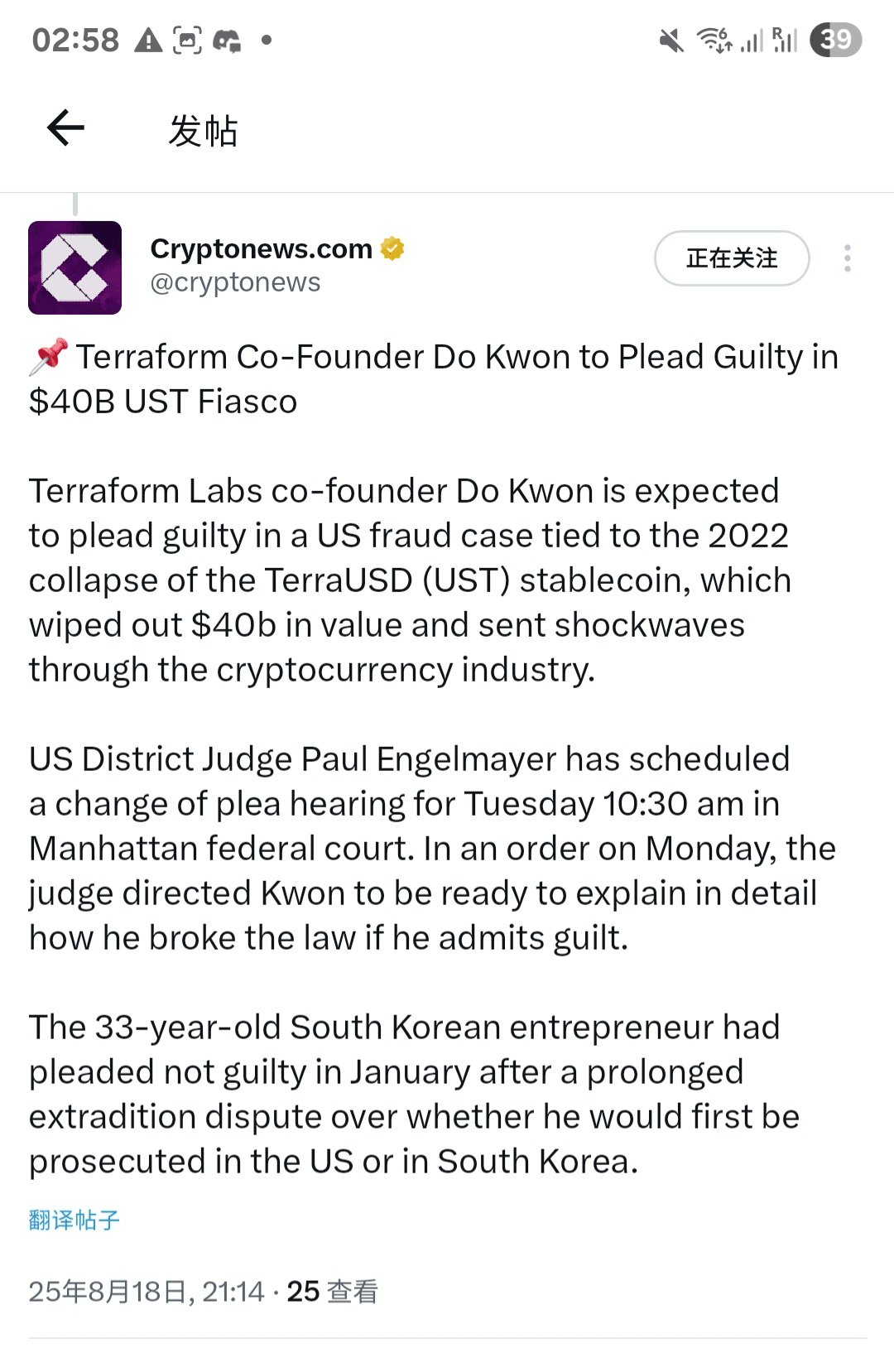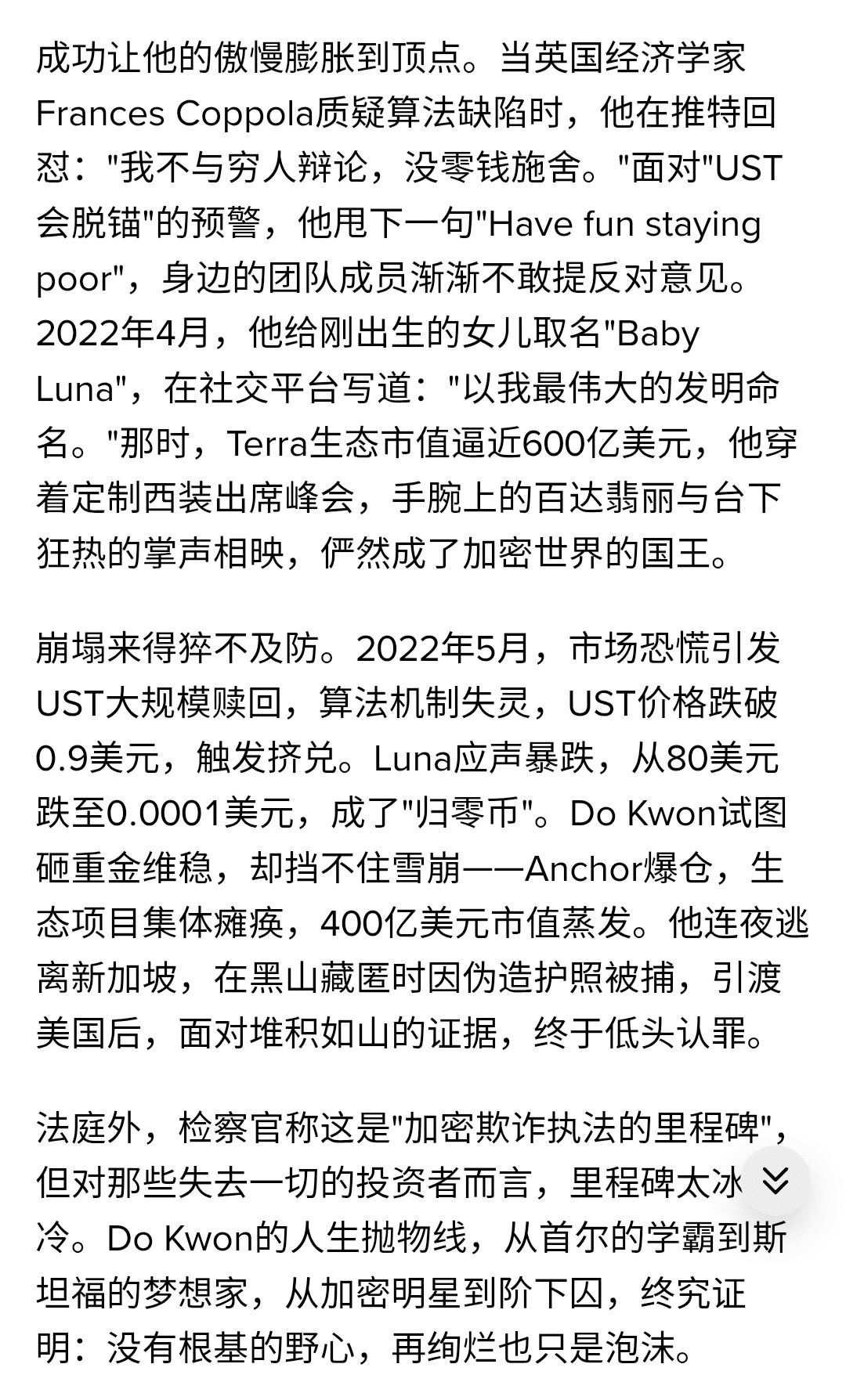Do Kwon from Terra is on trial, and yesterday it was reported that he is going to plead guilty.

I started selling BTC to buy NFTs and speculate on altcoins when UST/Luna had just collapsed.
Six months later, FTX also collapsed.
At that time, I had just downloaded the FTX Pro app, and I had just transferred money to open a contract (I remember buying AR), and after 200 U, I got liquidated, and the explosive head got caught. After a while, I couldn't open FTX Pro anymore.
I still have this FTX Pro app on my phone and haven't deleted it.

✅ Do Kwon founded Terraform Labs in Singapore in 2018 and issued an algorithmic stablecoin called TerraUSD (UST), while also issuing the cryptocurrency Luna.
UST (stablecoin) and Luna (governance coin) operate as a dual-token system:
When the price of the stablecoin UST is above 1 dollar, for example, reaching 1.05 dollars, arbitrageurs will spend 1 dollar of Luna to exchange for 1 UST from the Terra system, then sell UST in the market for 1.05 dollars, thus making a profit of 0.05 dollars.
Result: Luna was destroyed, UST was issued → UST supply increased → UST price fell back to 1 dollar.
Through operations initiated by arbitrageurs, smart contracts in the Terra system automatically destroyed Luna and issued UST, maintaining the UST price stable at 1 dollar;
Similarly, when USDT drops below 1 dollar, for example, to 0.95 dollars, arbitrageurs will spend 0.95 dollars to buy 1 UST, exchange that 1 UST for 1 dollar worth of Luna in the Terra system, and then sell the Luna for 1 dollar, making a profit of 0.05 dollars.
In this process, the Terra system destroyed UST and issued Luna. The UST supply decreased → UST price rose back to 1 dollar.
The Terra protocol itself only provides an exchange mechanism (on-chain swap), with the UST price relying on algorithms and the operations of arbitrageurs to maintain its peg.
Therefore, UST is referred to as an algorithmic stablecoin.
✅ However, in May 2022, the algorithmic stablecoin UST de-pegged.
The reason for the de-pegging was that the main application scenario for UST at the time was the Anchor protocol (where depositing UST could earn a 20% annual interest). In early May, a large amount of funds suddenly withdrew UST from Anchor, amounting to hundreds of billions of dollars in just a few days, leading to an oversupply of UST in the market.
Due to the selling pressure from the oversupply of UST, the price of UST dropped from 1 dollar to 0.98 dollars.
✅ Theoretically, arbitrageurs would then buy UST at the cheap price of 0.98 dollars, then destroy the UST in the Terra system and exchange it for Luna to sell and realize the value, quickly bringing the UST price back up to 1 dollar.
Initially, arbitrageurs continuously operated, destroying UST while massively issuing Luna. However, the short-term massive issuance of Luna also caused a certain drop in Luna's price, raising concerns among arbitrageurs that the Luna obtained by selling UST would continue to depreciate, directly resulting in insufficient arbitrage motivation and failing to quickly correct the de-pegging price of UST.
At the same time, the issuance of Luna led to a drop in Luna's price → further loss of market confidence → more people sold UST.
The vicious cycle led to UST completely losing its peg, with the price rapidly plummeting from nearly 1 dollar to about 0.1 dollars, while Luna's price also collapsed from about 119 dollars to almost zero.
Within a week, these two assets evaporated hundreds of billions of dollars in market value.
✅ Looking back, the trigger for the collapse of Luna was the sudden withdrawal of a large amount of funds from the Anchor protocol in May 2022.
Anchor is the 'killer application' of the Terra ecosystem, allowing retail and institutional investors to deposit UST and earn nearly 20% fixed annual returns (referred to as 'low-risk stablecoin investment').
However, this 20% yield is not a natural market interest rate but is maintained through continuous subsidies from Terraform Labs and Luna Foundation Guard (LFG).
In fact, Anchor's interest payments exceeded its lending income, resulting in a long-term loss of reserves. By March to April 2022, Anchor's 'yield reserve' began to be rapidly depleted, and the market had already noticed that the subsidies were about to run out. Once the subsidies decreased and interest rates fell, investors had no reason to continue holding UST.
Thus, the large withdrawal of UST funds from the Anchor protocol in May 2022 had already shown signs.
✅ I've always been curious, didn't those who heavily invested in Luna and the stablecoin UST ever think that both coins would crash simultaneously, and that the stablecoin UST would quickly de-peg? I saw that some economists raised doubts at the time, but they did not attract attention.

If it were just a few thousand or a few hundred U from retail investors, probably no one would do such detailed investigations and calculations.
Did those big players who invested millions of U not even do the math? Don't they need an actuary to calculate the insurance, but they don't need to calculate when buying Luna and UST?
Before May 2022, what proportion of UST holders noticed that the Anchor subsidies were about to run out and withdrew their UST funds from the Anchor protocol in advance? Were they lucky enough to cash out before UST dropped to 0.1?
🔴 Those who are preparing to trade, hold, or deposit USD1 to obtain $WLFI tokens recently, do you feel a bit familiar?
But there's no need to worry, USD1 is not an algorithmic stablecoin, but is backed by real assets like short-term U.S. Treasury bonds held by licensed custodial institutions authorized by the U.S. government, ensuring high liquidity for USD1 to be exchanged 1:1 for U.S. dollars. This is also a compliance requirement in the stablecoin bill recently passed by the U.S. Congress, which mandates that stablecoins must be backed 1:1 by high liquidity real assets like short-term U.S. Treasury bonds held by licensed custodial institutions in the U.S. Users holding USD1 stablecoins, regardless of the amount, can exchange them for U.S. dollars anytime they wish.
The reason UST collapsed is that UST is an algorithmic stablecoin and is not backed by real assets to maintain liquidity for UST to be exchanged 1:1 for U.S. dollars.
Algorithmic stablecoins are unregulated air coins.
✅ The collapse of Luna in May 2022 indirectly led to the collapse of FTX in November 2022.
The reason is that the collapse of Luna triggered a deleveraging in the entire cryptocurrency industry, with giants like 3AC (Three Arrows Capital), Celsius, and Voyager facing massive losses and going bankrupt due to holding large amounts of UST/Luna, investing UST in the Anchor protocol, or lending to 3AC like Voyager.
Alameda, the brother company of the FTX exchange and a cryptocurrency quantitative trading and market-making firm, also held a huge position in the Luna ecosystem. The collapse of UST/Luna caused significant losses for Alameda. To cover the losses, Alameda and FTX used customer funds to fill the gap.
When the CoinDesk report in November 2022 revealed anomalies in Alameda's balance sheet, the market quickly and violently initiated a 'bank run' on FTX, leading to the rapid collapse of the FTX exchange.
🚩 In this historic event, giants like 3AC (Three Arrows Capital), Celsius, and Voyager are essentially on the same level as us small retail investors. Poor risk control and lack of judgment mean that no matter how large the institution is, it is still a part of the market.

